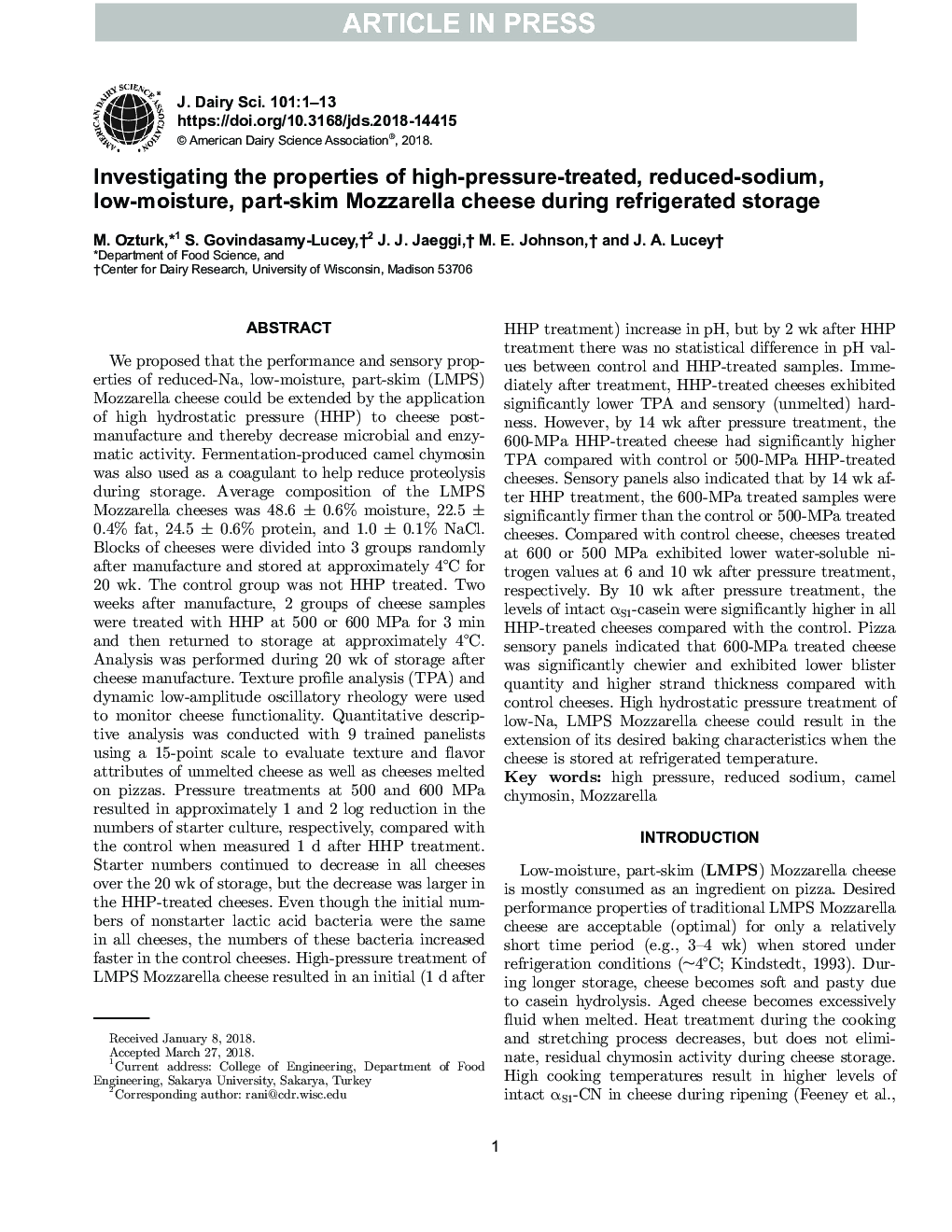| کد مقاله | کد نشریه | سال انتشار | مقاله انگلیسی | نسخه تمام متن |
|---|---|---|---|---|
| 8500856 | 1553837 | 2018 | 13 صفحه PDF | دانلود رایگان |
عنوان انگلیسی مقاله ISI
Investigating the properties of high-pressure-treated, reduced-sodium, low-moisture, part-skim Mozzarella cheese during refrigerated storage
ترجمه فارسی عنوان
بررسی خواص رطوبت با فشار بالا، کاهش سدیم، کم رطوبت، پنیر ماتسرلا پنیر نیمه خشک در هنگام ذخیره سازی سرد
دانلود مقاله + سفارش ترجمه
دانلود مقاله ISI انگلیسی
رایگان برای ایرانیان
کلمات کلیدی
فشار بالا، کاهش سدیم، شیم چینی موتزارلا،
موضوعات مرتبط
علوم زیستی و بیوفناوری
علوم کشاورزی و بیولوژیک
علوم دامی و جانورشناسی
چکیده انگلیسی
We proposed that the performance and sensory properties of reduced-Na, low-moisture, part-skim (LMPS) Mozzarella cheese could be extended by the application of high hydrostatic pressure (HHP) to cheese postmanufacture and thereby decrease microbial and enzymatic activity. Fermentation-produced camel chymosin was also used as a coagulant to help reduce proteolysis during storage. Average composition of the LMPS Mozzarella cheeses was 48.6 ± 0.6% moisture, 22.5 ± 0.4% fat, 24.5 ± 0.6% protein, and 1.0 ± 0.1% NaCl. Blocks of cheeses were divided into 3 groups randomly after manufacture and stored at approximately 4°C for 20 wk. The control group was not HHP treated. Two weeks after manufacture, 2 groups of cheese samples were treated with HHP at 500 or 600 MPa for 3 min and then returned to storage at approximately 4°C. Analysis was performed during 20 wk of storage after cheese manufacture. Texture profile analysis (TPA) and dynamic low-amplitude oscillatory rheology were used to monitor cheese functionality. Quantitative descriptive analysis was conducted with 9 trained panelists using a 15-point scale to evaluate texture and flavor attributes of unmelted cheese as well as cheeses melted on pizzas. Pressure treatments at 500 and 600 MPa resulted in approximately 1 and 2 log reduction in the numbers of starter culture, respectively, compared with the control when measured 1 d after HHP treatment. Starter numbers continued to decrease in all cheeses over the 20 wk of storage, but the decrease was larger in the HHP-treated cheeses. Even though the initial numbers of nonstarter lactic acid bacteria were the same in all cheeses, the numbers of these bacteria increased faster in the control cheeses. High-pressure treatment of LMPS Mozzarella cheese resulted in an initial (1 d after HHP treatment) increase in pH, but by 2 wk after HHP treatment there was no statistical difference in pH values between control and HHP-treated samples. Immediately after treatment, HHP-treated cheeses exhibited significantly lower TPA and sensory (unmelted) hardness. However, by 14 wk after pressure treatment, the 600-MPa HHP-treated cheese had significantly higher TPA compared with control or 500-MPa HHP-treated cheeses. Sensory panels also indicated that by 14 wk after HHP treatment, the 600-MPa treated samples were significantly firmer than the control or 500-MPa treated cheeses. Compared with control cheese, cheeses treated at 600 or 500 MPa exhibited lower water-soluble nitrogen values at 6 and 10 wk after pressure treatment, respectively. By 10 wk after pressure treatment, the levels of intact αS1-casein were significantly higher in all HHP-treated cheeses compared with the control. Pizza sensory panels indicated that 600-MPa treated cheese was significantly chewier and exhibited lower blister quantity and higher strand thickness compared with control cheeses. High hydrostatic pressure treatment of low-Na, LMPS Mozzarella cheese could result in the extension of its desired baking characteristics when the cheese is stored at refrigerated temperature.
ناشر
Database: Elsevier - ScienceDirect (ساینس دایرکت)
Journal: Journal of Dairy Science - Volume 101, Issue 8, August 2018, Pages 6853-6865
Journal: Journal of Dairy Science - Volume 101, Issue 8, August 2018, Pages 6853-6865
نویسندگان
M. Ozturk, S. Govindasamy-Lucey, J.J. Jaeggi, M.E. Johnson, J.A. Lucey,
